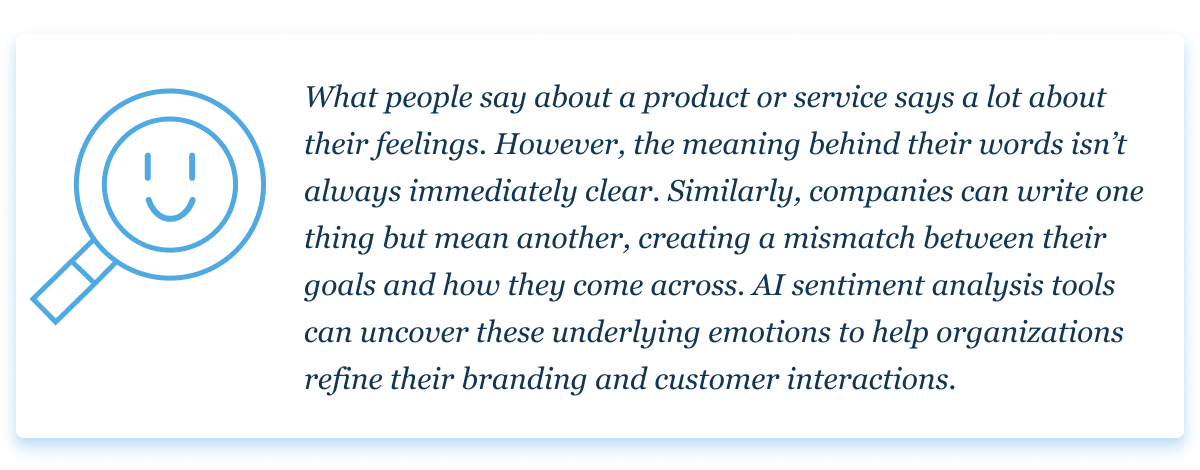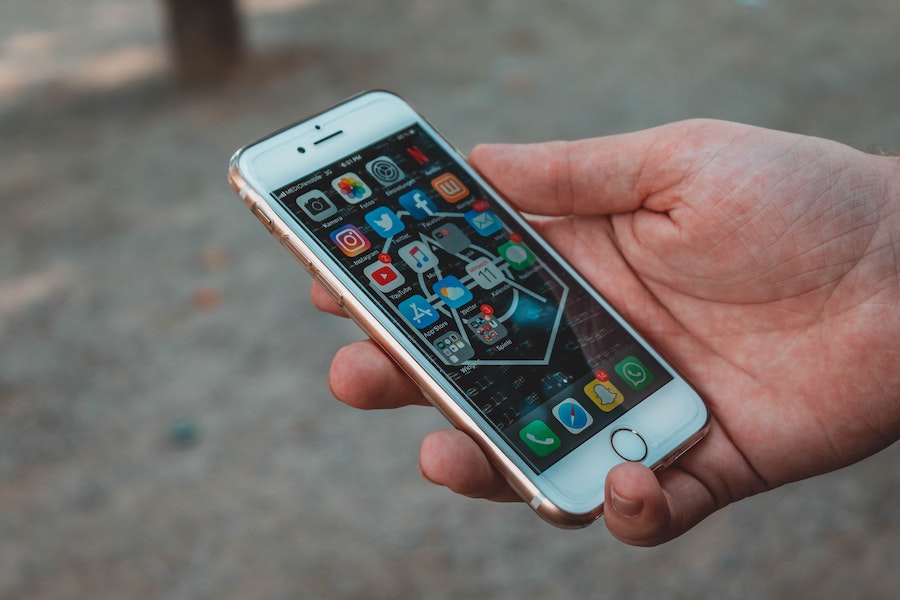Artificial intelligence (AI) is a remarkably versatile technology, offering many specific use cases for businesses looking to capitalize on their data. One of the most helpful of these applications is AI sentiment analysis, which marries the benefits of consumer sentiment analytics with AI’s accuracy, speed and capacity. Using a sentiment analysis model can unlock a marketing department’s full potential.
What is AI sentiment analysis?
The field of sentiment analysis involves looking at text to determine what opinions, emotions and attitudes it reflects. Sentiment analysis AI automates much of this process by employing natural language processing (NLP).

Sentiment analysis itself predates AI and doesn’t necessarily need it to work. However, bringing NLP into the picture makes the process far easier and more reliable. As machine learning consulting and development grows, companies that don’t capitalize on these tools may quickly fall behind their more tech-centric competition.
Types of sentiment analysis
Just as there are many applications of natural language processing in general, several types of sentiment analysis exist. Here’s a closer look at the four main categories.
Fine-grained analysis
The most basic form of sentiment analysis is fine-grained analysis. This approach divides users’ sentiments across a polar scale ranging from very negative to very positive, with multiple levels in between. Star ratings that ask customers to rank purchases or experiences from one to five stars are one of the most common examples.
The primary advantages of this kind of analysis are that it’s precise and easy to understand. Having users explicitly rank things as positive, negative or neutral leaves little room for interpretation and is fairly easy to implement. It may not require an AI sentiment analysis tool at all.
On the downside, this simplicity also doesn’t leave room for nuance and isn’t applicable in every situation. It also requires users to actively engage in the review process, potentially limiting results.

Source: Unsplash
Aspect-based analysis
Aspect-based analysis is a more detailed type of sentiment analytics. Like fine-grained analysis, it often uses a polar scale to rank emotions. However, this type of customer review sentiment analysis goes deeper by considering which aspects of the product or service elicited different reactions.

In either case, aspect-based analysis is more complex than fine-grained methods, making it more challenging to implement. However, it offers more insight into specific sentiments.
Emotion detection
Emotion detection is a less widespread but growing type of AI sentiment analysis. Instead of looking at black-and-white scales and numbers, this approach focuses on understanding the emotions of a body of text.
This type of sentiment analysis has many specific use cases. Some organizations may use it to analyze social media posts to see if users are talking negatively or positively about a company. Others may use it to judge the emotion of their own copy to determine if it sounds like they want it to.
Because many words have different meanings in various contexts, these sentiment analysis algorithms are often more complex. These nuances can create some confusion, but advances in AI software development have made these NLP models fairly reliable.

Source: Unsplash
Intent-based analysis
The fourth and most unique kind of sentiment analysis is intent-based analysis. As the name suggests, this approach aims to understand why customers, employees or other parties act the way they do.

This method doesn’t necessarily involve text analysis, as it’s possible to understand user intent without words. However, including NLP features in these sentiment analysis models makes them more well-rounded.
Sentiment analysis AI use cases
Because sentiment analysis models come in so many forms and understanding users’ sentiments is applicable in various situations, this technology has several unique use cases.
Here are some of the most prevalent applications.
Customer service
Automating customer service workflows is one of the most popular applications of AI in the service industry, so it should be no surprise that it’s an ideal application for sentiment analysis. Artificial intelligence sentiment analysis can analyze customers’ messages to understand their needs and feelings, informing more appropriate responses.

It’s important to remember that each risk includes two main components — something that could happen and the consequences if it doesn’t. Effective AI sentiment analysis tools will feature both when ranking task urgency.
For example, they should consider how a text reflects the likelihood of losing that customer and how big an impact that specific loss would have.
Social media analysis
Another common example of sentiment analysis in artificial intelligence is reviewing social networks to gauge consumer feelings. Machine learning algorithms can scour social media posts for mentions of a company or its products, then use emotion detection to determine what these posts express.
Organizations will then understand what people like about them, what they don’t and how they may change to promote a better public image.

Source: Unsplash
Social media is one of the best places to gauge consumer sentiments, as 72% of American adults use these sites, with many doing so daily.
Companies can also perform AI sentiment analysis on social media to find and respond to people asking questions about their products or services on these platforms.
Marketing research
Similarly, businesses can use sentiment analysis AI to understand their target markets better. A common approach is to analyze social media posts to see how different demographics feel about some features or competitors’ offerings.

Companies may use similar algorithms for sentiment analysis to judge the efficacy of their other AI marketing solutions and strategies.
Comparing consumer sentiments after employing these systems to what people were saying before helps direct future marketing decisions. Whatever the specifics, the more a business understands its target niches, the more effectively it can advertise to them.
Understanding employees
Using sentiment analysis in artificial intelligence can also reveal trends outside of customer circles. Some organizations may deploy these algorithms to gain insight into their workforce.
With voluntary employee turnover rates reaching 20% higher than the pre-pandemic average, businesses today need to consider what workers want from their employers.

Source: Unsplash
Sentiment analysis can reveal what consumers think of a brand and highlight employees’ feelings about their workplace. AI models can scan reviews on sites like Glassdoor and employee survey responses to find common emotions and thoughts. Company leadership can use this data to guide organizational changes to improve employee engagement and reduce turnover.
Brand voice insights
Another internal application of artificial intelligence sentiment analysis is reviewing brand voicing. It’s easy for a company to write marketing copy to express one idea and accidentally express another through word choice or sentence structure.
NLP models can review this text data to reveal how something may come across, letting marketers adjust if necessary before publishing anything.

Source: Unsplash
This kind of AI sentiment analysis can also help customize base marketing materials to appeal better to various niches.
Writers can use these tools to ensure a piece targeting one audience carries a different tone than another. This customization helps market to various consumer groups more effectively, with AI removing much of the guesswork.
Why should businesses use AI sentiment analysis?
It’s possible to manually look through posts and other text strings to gauge their sentiments. However, automating this process with AI presents several advantages over manual methods.

Looking through even a small fraction of that information could take days for a human, but AI can do it in mere minutes.
Machine learning algorithms are more accurate than humans when analyzing trends.
Understanding word choice is a complex, multifactor undertaking, which makes it easy for people to make mistakes. However, AI can deliver the same quality of results every time. AI’s thoroughness may also highlight trends and insights humans may miss.

Source: Unsplash
Finally, sentiment analysis in artificial intelligence reduces the workload on human employees. By automating these data-heavy tasks, companies can spend more time and energy acting on insights than gathering them.
How to choose and deploy a sentiment analysis model
The efficacy of a sentiment analysis model hinges on how well an organization can implement it. Here are some important steps to remember to make the most of these algorithms, whether using a ready-made option or an AI builder for sentiment analysis models.
Understand the organization’s needs
The first step in using AI to automate sentiment analysis is determining what the algorithm needs to deliver. With so many use cases and model types, there’s no single answer to the best algorithm. Rather, teams must review their budgets and goals to decide what features and strengths they need.
Will the organization use this model for customer service, market research, survey analysis, brand image monitoring or something else? Where have previous efforts in these areas fallen short? How much time and money can the organization spend on training an algorithm? The answers to questions like these will help guide businesses toward the ideal sentiment analysis algorithm.
Review available options
Next, businesses should consider what models and approaches fall within the scope of their needs and budget.
For some, ready-made algorithms like Google’s AI sentiment analysis tools may be best. A lack of time or expertise for algorithm development is one of the most common barriers to machine learning, so off-the-shelf options are ideal for many organizations.
Companies with proper experience or more specific needs may want to build their own models. If they take this course, they should review what types of algorithms would best match their goals. A bag-of-words model in sentiment analysis can help streamline development by simplifying the analytics process, but word embedding is better at understanding context.
Set relevant KPIs
Once organizations have the sentiment analysis model they need, they should determine relevant key performance indicators (KPIs) to track the project’s success. Like the models themselves, these will vary among specific use cases.

Source: Unsplash
KPIs should align with the project’s goals. Tracking changes in customer satisfaction scores can help judge a customer service AI, whereas sales changes may be more relevant for marketing research algorithms.
Start small and grow slowly
Finally, as with any artificial intelligence project, businesses should start by applying sentiment analysis where it’ll have the greatest impact. They can slowly use it in other workflows and projects as they begin to see positive results, keeping in mind what worked and didn’t in the first project.
About 60%-80% of AI projects fail. Companies that want to avoid becoming part of that statistic should approach this technology carefully. Starting small, keeping track of successes and failures, and scaling slowly will help make the most of these projects.
Author bio
April Miller is a senior writer with more than 3 years of experience writing on AI and ML topics.
Get started in AI sentiment analysis today
Sentiment analysis is one of the most useful AI applications for businesses today. Teams that understand these tools and how they can help them achieve their goals can use them to maximize their potential. Marketing strategies, consumer outreach, brand sentiments and employee retention can all see improvements.



